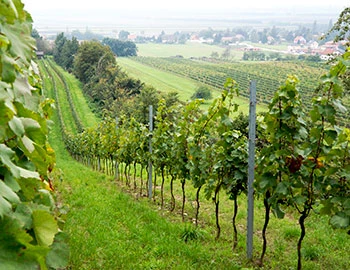Blaufränkisch Spitzerberg 2016
QWt Carnuntum, Weingut Trapl, 750 ml

| Grape variety: | Blaufränkisch |
| Producer: | Trapl |
| Origin: | Austria / Niederösterreich / Carnuntum |
Attributes
| Origin: | Austria / Niederösterreich / Carnuntum |
| Site / vineyard: | Obere Panhölzer |
| Grape variety: | Blaufränkisch |
| Label: | Vegan, Certified organic or biodynamic wine |
| Ripening potential: | 3 to 10 years after harvest |
| Drinking temperature: | 16 to 18 °C |
| Food Pairing: | Châteaubriand, Filet Wellington, Spiced grillades, Saddle of lamb fillet with herb jus, Roasted lamb gigot, Roast saddle of venison |
| Vinification: | partly destemmed, with stalks attenuated, stamped by foot, short must fermentation, fermentation in wooden barrel, soft pressing |
| Harvest: | strict selection, in small boxes, hand-picking with simultaneous grape sel |
| Maturation: | in tonneau |
| Maturation duration: | 18 months |
| Volume: | 13.0 % |
| Note: | Contains sulphites |
Blaufränkisch
Fanned by warm winds
The Blaufränkisch fits in comfortably in Burgenland and in neighbouring Hungary. Caressed by the warm winds of the Pannonian Plain and protected by hills and mountains, the grapes can fully ripen. They yield fine, dark-berried, well-structured red wine. Depending on taste, the vintner presses them lightly and fruitily, or gathers them in wooden casks into firm, peppery wines. They are predestined for ripeness, and pair excellently with meat and game dishes. The name of this wine is deceptive: in the middle ages, grapes from southern Germany were called “Frankisch”. They were seen as particularly sophisticated. The Blaufränkisch, however, is a native of Austro-Hungary. In Hungary, where it is called Kékfrankos, it even occupies twice as much vineyard space as in Austria. Some producers make wine on both sides of the border.

Carnuntum
Carnuntum: Red finesse in Zweigelt country
With a cultivation area of just 910 hectares, stretching from Vienna’s city limits to the Slovak border, Carnuntum is one of Austria’s smallest wine regions. However, a wide diversity of red wines is cultivated here, from drinkable Zweigelt Rubin to multi-faceted Blaufränkisch from Spitzerberg to Merlot and Cabernet Sauvignon. Also highly interesting is the interplay between Bordeaux varieties and the native Zweigelt and Blaufränkisch cultivars.

Niederösterreich
Lower Austria: crus near and far from the Danube
Austria's largest state is also its largest wine region. 46,000 hectares are planted with vines in Lower Austria. It is a heterogenic wine region, consisting of eight wine growing areas. While white varieties like Grüner Veltliner and Riesling dominate in the areas north and west of Vienna, red varieties set the tone in the south and in the southeast (Thermenregion and Carnuntum). The internationally famous white crus from Grüner Veltliner and Riesling develop in the picturesque Wachau and Kamptal.

Austria
Austria – Sumptuous culture, accessible to all
Austria is characterized by unbelievable topographical diversity. A flat steppe in the east, forests and hills in the Alpine regions, wetlands and Mediterranean landscapes in the south. This in addition to a rich tradition and even greater love. It’s no surprise that the Romans found joy on this patch of Earth and cultivated wine growing. Austrian wine is not abundant, but it is high quality.







